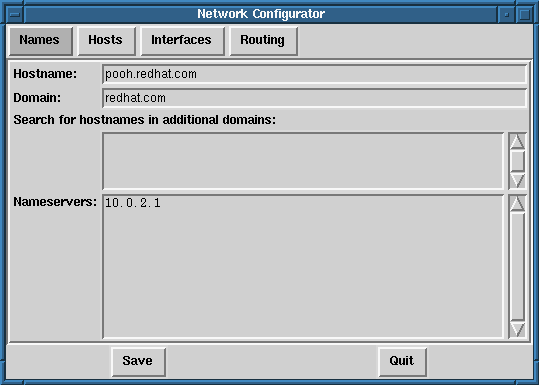
The network configuration tool (netcfg) shown in Figure 59 is designed to allow easy manipulation of parameters such as IP address, gateway address, and network address, as well as name servers and /etc/hosts.

Network devices can be added, removed, configured, activated,
deactivated and aliased. Ethernet,
arcnet, token ring, pocket (ATP), PPP, SLIP, PLIP and loopback devices
are supported. PPP/SLIP/PLIP support works well on most hardware, but
some hardware setups may exhibit unpredictable behavior. When using
the Network Configuration Tool click Save to write your
changes to disk, to quit without making any changes select
Quit.
The Names panel of the Network Configuration tool serves two
primary purposes: setting the hostname and domain of the computer, and
determining which name server will be used to look up other hosts on
the network. The Network tool is not capable of configuring a machine
as a nameserver. To edit a field or add information to a field simply
click on the field with the left mouse button and type the new
information.
In the Hosts management panel you have the ability to add,
edit, or remove hosts from the /etc/hosts file. Adding or
editing an entry involves identical actions. An edit dialog box will
appear, simply type the new information and click Done when
you are finished. See Figure 60 for an example.
If you have added a networking interface to your machine since
installing Red Hat Linux, or you didn't configure your ethernet card at
install time, you can configure it with a few clicks of a mouse.
Please Note: You may need to configure kerneld to load a driver for
the network interface you are adding (e.g., eth0); see Section
9.6 for more information.
Begin adding an interface by clicking on Interfaces in the
main panel. This will bring up a window of configured devices with a
row of available options, see figure 61.
To add a device, first click the Add button then select the
type of interface you want to configure from the box that appears
(See Figure 62).
Please Note: There is now a clone button available in netcfg.
This button can be used to create a ``clone'' of an already-existing
interface. By using clone interfaces, it is possible for a laptop to have
one Ethernet interface defined for a work LAN, and a clone Ethernet device
defined for a home LAN.
Adding a PPP interface can be as simple as supplying the phone number,
login name and password in the Create PPP Interface dialog
shown in Figure 63. If you need to use PAP
authentication for your PPP connection, choose Use PAP
authentication. In many cases some degree of customization will be
needed to establish a PPP connection. Choosing the Customize
button will allow you to make changes to the hardware, communication,
and networking settings for the PPP interface.
In order to configure a SLIP interface you must first supply a phone
number, login name, and password. This will supply the initial
parameters for the chat script needed to establish a SLIP connection.
When you choose Done, a dialog titled Edit SLIP
Interface appears that enables you to further customize the hardware,
communication and networking parameters for your SLIP interface.
To add a PLIP interface to your system you only have to supply the IP
address, the remote IP address, and the Netmask. You can also select if
you want to activate the interface at boot time.
If you are adding an ethernet, arcnet, token ring or pocket adapter to your
computer you will need to supply the following information:
The network and broadcast addresses are calculated automatically
based on the IP address and netmask you enter.
After providing the configuration information for your new device,
click Done. The device should appear in your
Interfaces list as an inactive device. (The active column
should have a label of no). To activate the new device, first
select it with a mouse click and then choose on the Activate
button. If it does not come up properly, you may need to reconfigure it
by choosing on Edit.
In the Routes management screen you have the ability to add, edit, or
remove static networking routes. Adding or editing an entry involves
identical actions, just like the Hosts panel. An edit dialog box will
appear, simply type the new information and click Done when
you are finished. See figure 64 for an example.
9.4.1 Managing Names
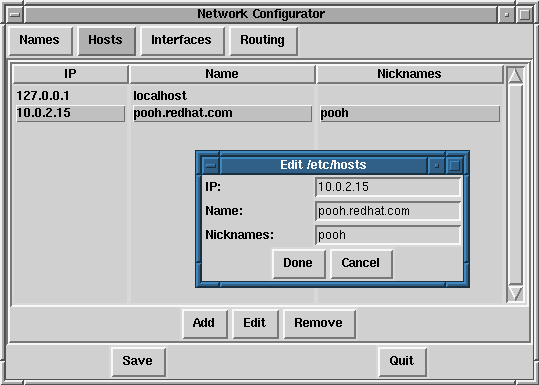
9.4.2 Managing Hosts
9.4.3 Adding a Networking Interface
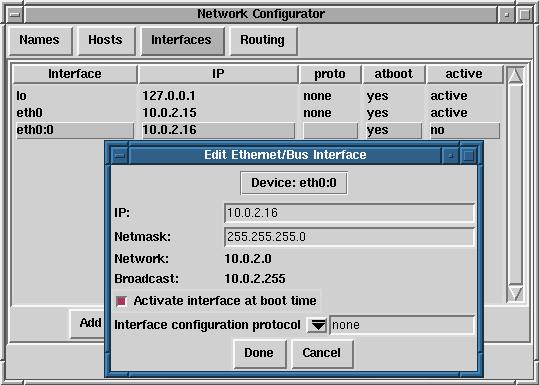
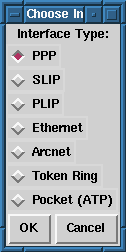
9.4.3.1 PPP Interface
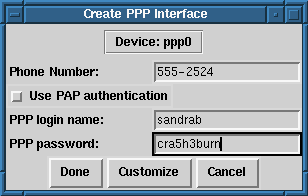
9.4.3.2 SLIP Interface
9.4.3.3 PLIP Interface
9.4.3.4 Ethernet, Arcnet, Token Ring and Pocket Adaptor Interfaces
9.4.4 Managing Routes
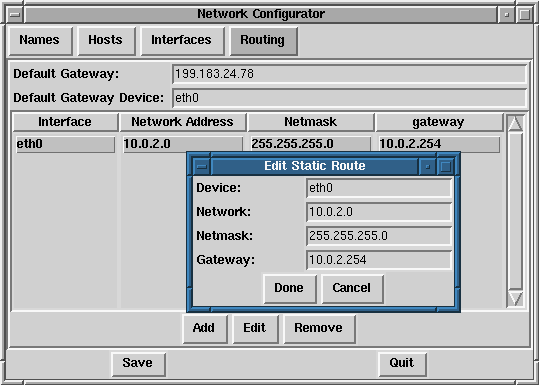
![]()
![]()
![]()
![]()
![]()